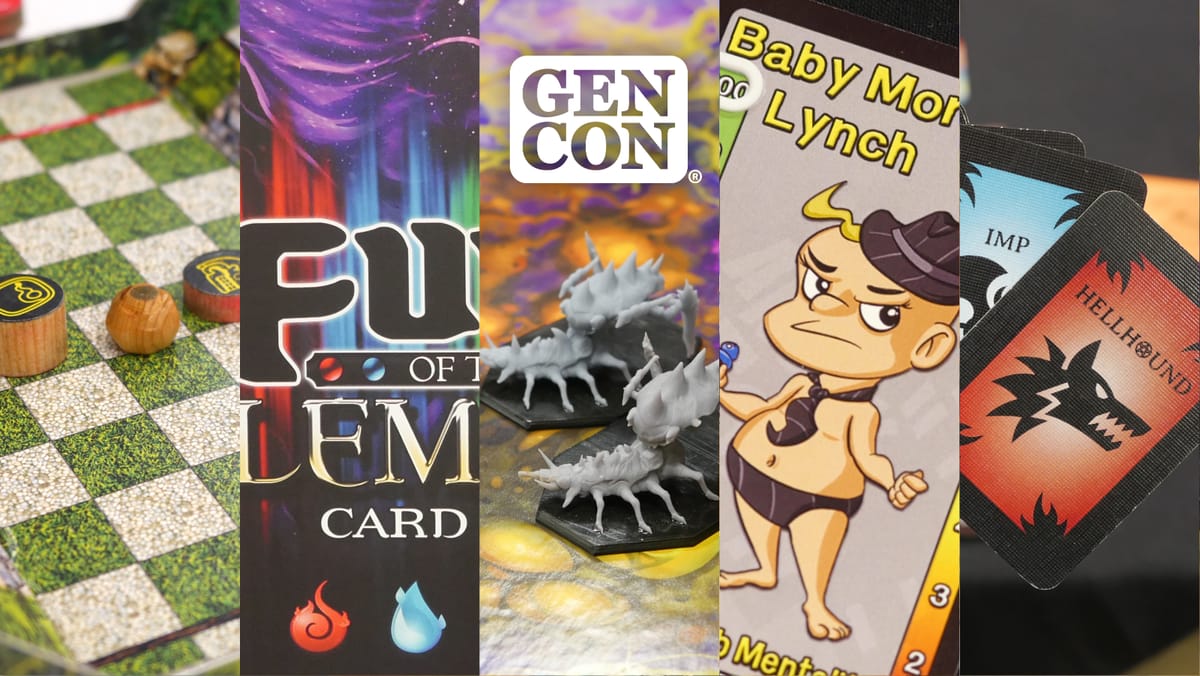
At Gen Con Indy 2023 I had the opportunity to spend some time in the First Exposure Playtest Hall. There were dozens of games being playtested every two hours each day and I was able to play a small sample of them. These are all games that are in varying stages of development, none of them yet produced, so all images are of prototype components. Here’s what I got to try!
Fury of the Elements
Fury of the Elements is a two player card game inspired by Triple Triad and Magic: The Gathering. Each player has an identical deck of element cards. There are four types: wind, earth, fire, and water, each with a strength between 1 and 4. Cards with higher strength are purely stronger than cards with lower strength. Each card also has a number of arrows equal to its strength pointing in different orthogonal directions. Players have a hand size of 5 cards which they always draw up to at the end of their turn.
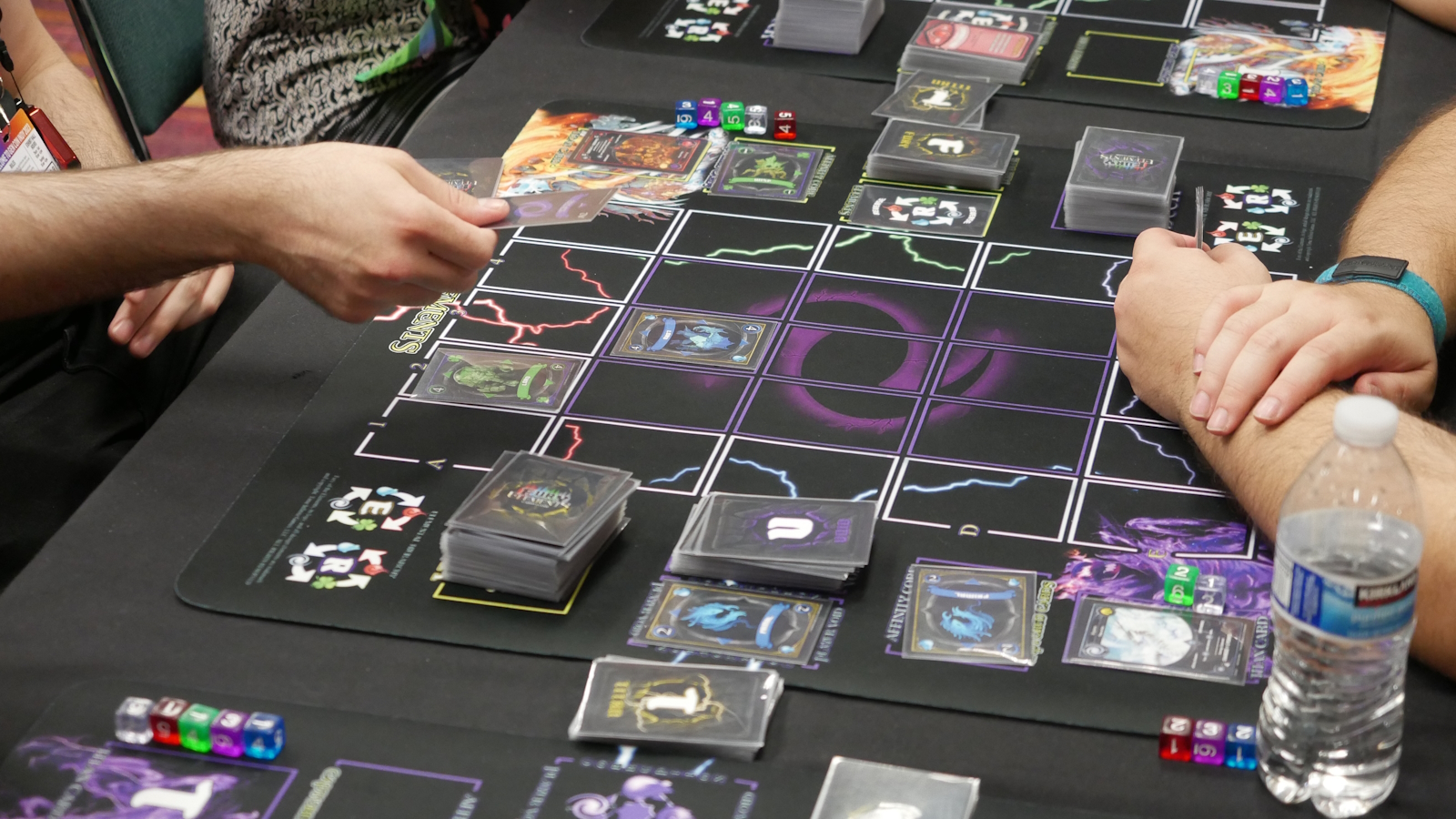
Players alternate turns placing cards on a 5 x 5 grid. The player currently placing their card is considered to be attacking and they have the possibility of capturing the neighboring opponent’s cards. If any of the attacking card’s arrows are pointing towards the adjacent opponent’s cards, those cards are considered defending and you check a few things. If the defender is the same element as the attacker then there is no conflict; cards of the same element never fight. If the defender is a different element and does not have an arrow pointing back at the attacker then it is captured regardless of strength. This allows for strategic play with lower strength cards.
If the defender does have an arrow pointing back it will be captured if the attacker’s strength is greater. If the defender’s strength is greater, then the card is not captured. If the strengths of the attacker and defender are equal then you have to check the elemental hierarchy. This is a two sided card that has the four elements in a circle with arrows between them, clockwise on one side of the card and counterclockwise on the other side. If the hierarchy has the attacking element pointing towards the defending element, then the attacker captures the defender. If the defending element is pointing towards the attacking element, then there is no capture. If, however, the elements are on opposite sides of the hierarchy then there is a clash.
There is no capture when a clash happens, however it does two things. First, the hierarchy card flips to the other side. Second, a void gets opened on the board causing chaos. The void deck is 25 cards, one for each location, each also having a different number of arrows pointing in different directions. A clash causes one card to be drawn from the void deck. That void card is placed on the location indicated, sending any elemental cards underneath it to a special discard pile. Any cards pointed to by the void card are turned face down. These cards are now vulnerable to any attack from an opponent, but they can also be rescued by the owning player playing adjacent to them.
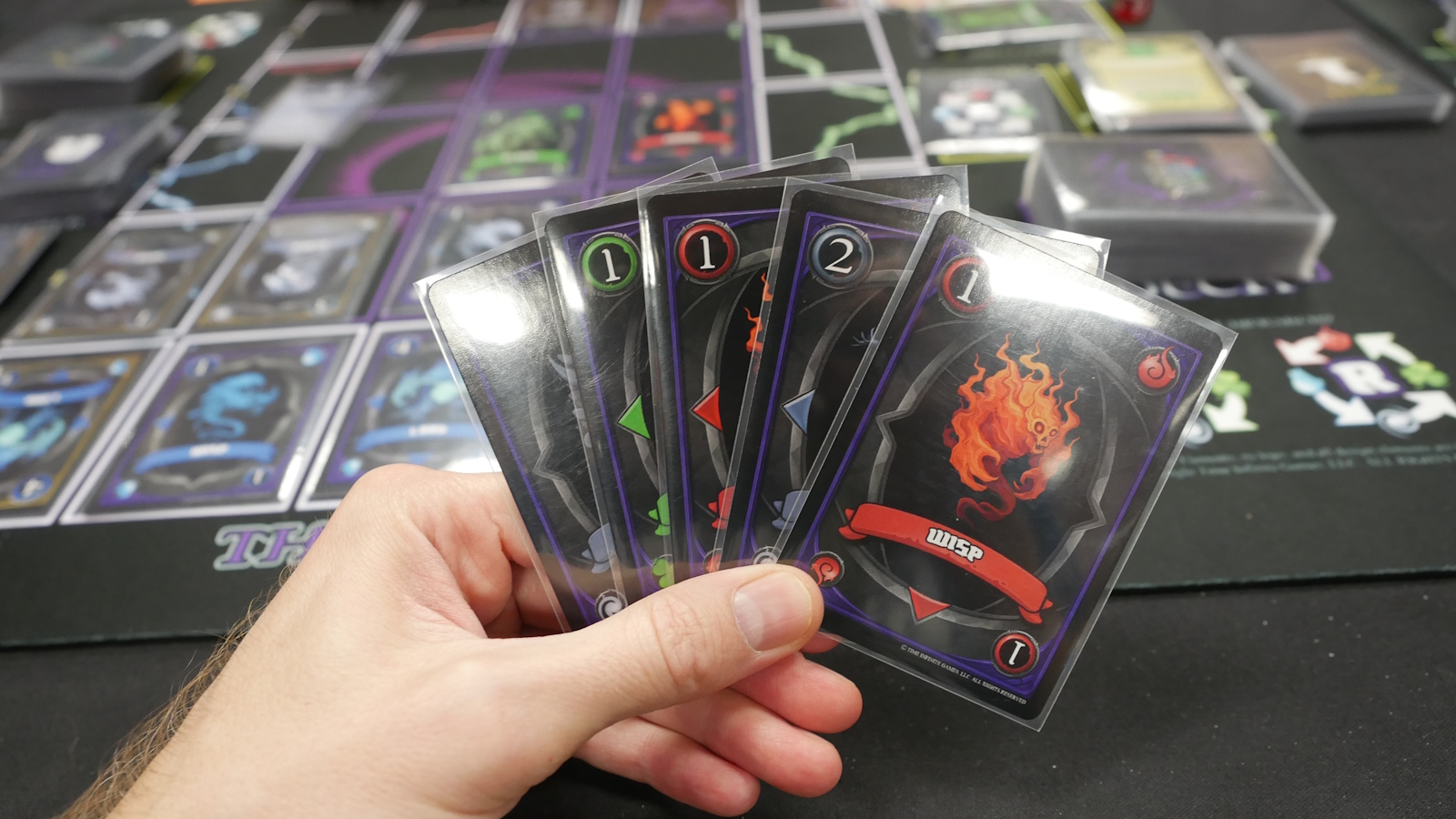
In addition to elemental and void cards there is also a shared titan deck. At the beginning of the game each player gets to pick a titan from this deck. The titan gives each player a special ability and a goal of sorts. If you capture the specified elements on your titan card then you get to activate it, either scoring some extra points or getting to clear a void on the board. After using an activated titan you get to draw another one at random.
After a player has placed a card and resolved any conflicts they also check to see if they have formed a line of cards of the same element, either three, four, or five cards vertically or horizontally. Which player placed the cards doesn’t matter, if they have made such a line then they get to draw a card from the fury deck and receive the reward on it. This is another shared deck of cards which are face up so that the next reward can be seen. Most of these give one-time abilities and elements towards activating their titan. More importantly though there are 4 elemental fury cards in this deck that will give that player points for every card of that element still on the board at the end of the game. These can be very important and I found a lot of my strategy revolving around claiming these while preventing my opponent from doing so. The end of the deck is always the void fury card which is similar to the elemental fury cards, but for voids.
Players continue alternating turns until either the board is completely filled with cards or the fury deck has run out. When this happens the players count up their points to determine the winner. Every captured elemental card is worth its strength. Add to that any titans that were activated for points and also any elemental awards that were won. Highest number of points is the victor!
Fury of the Elements is very far along in development. All of the card art is high quality and as good as I’ve seen in most produced games. They even have a large neoprene playmat to play on with the board spaces and locations for all of the decks. They plan on launching a crowdfunding campaign soon so keep your eyes open for that!
Rift Zone: Contact
Rift Zone: Contact is a tabletop miniatures game controlled by an app using augmented reality (AR). The players each control a small force of units facing off in head to head combat. The demo games were 60 point armies composed of three models each. The models were 3d printed and quite large, each with a Radio Frequency Identification (RFID) tag inside for scanning with a phone. Each player uses their own phone running a dedicated app which contains all of the information on the units. Other than large hexagon board tiles and the models, no other game components were used.

The story involves a conflict over the neutral planet of Proxima Centauri by two space faring species, the United Earth Defense Force and the Scry’Ox Collective. After a violent first encounter, reinforcing fleets unintentionally caused rifts to form around the planet isolating the forces which are now locked in battle.
To play, one of the players hosts the game and then the other player joins over a network. They build their army by scanning in each model they want to use and then when both are ready the game begins with a random start player. Players alternate taking turns by activating a single unit. All units under a player’s control must be activated once before any become ready to be activated again. Activating a unit by scanning it allows it to move and attack.
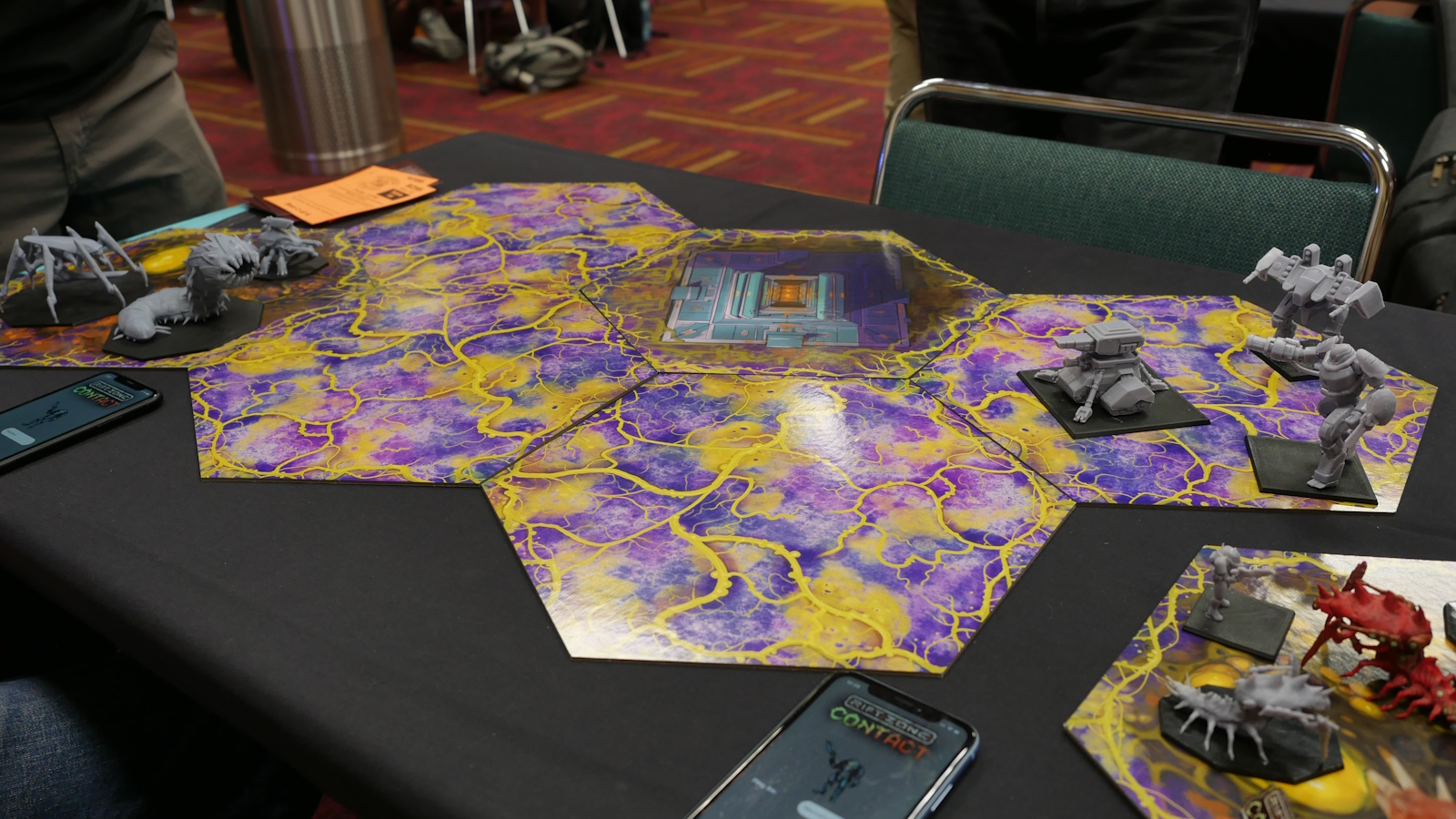
Movement is done through the camera by tapping where the unit is located and where it is moving to. The movement range of the unit is displayed as a ring using augmented reality. Units often have multiple weapons that they can choose between. After choosing a weapon to attack with, the AR will show the attack range and allow you to scan the unit to attack. The other player will have the option on their device to evade or choose a weapon to counter attack with. All of the calculations are done in the app. The core of an attack is rolling a D100 and you can have the app show all the details of your roll along with the defender’s roll. Results can range from a complete miss to a critical hit, which can disable a weapon or even the movement of a unit. Once a unit runs out of health it is removed from the board. First player to defeat all of the other player’s units wins!
Rift Zone: Contact is currently very early in development. The app which they are developing with proprietary technology is still bare bones. They have plans to rework a lot of the battle mechanics in order to continue to improve gameplay. They intend to ramp up augmented reality in order to have special effects displayed in the camera as units attack to go along with the sound effects that already exist. They also plan to allow players to use real world objects as terrain, which the game will automatically detect. There is huge potential here for implementing augmented reality into tabletop gaming and I think the possibilities are wide open. I look forward to seeing their progress next year. If they can pull this off and make a smooth, solid implementation, then I could see this game potentially winning a GamingTrend Best of Gen Con award in 2024!
Demon Summoner
Demon Summoner is a social deduction game designed by Chris Rech and Sav Bell. The game is an evolution of existing social deduction games and takes many core mechanics from Avalon. Players are given hidden roles at the start with some being righteous and some being evil. Each round the player with the leader token will choose a number of players to go on a crusade and then everyone votes for or against that group. If the vote fails the leader token moves clockwise and the procedure is repeated. If there are too many fail votes then the final team is automatically successful. Each crusader will then receive a secret demon of which there are two types. Imps may either be captured or released, but Hellhounds must be released. Over the course of four crusades the evil team will win if at least half of the demons have been released while the righteous will win if more than half of the demons have been captured.
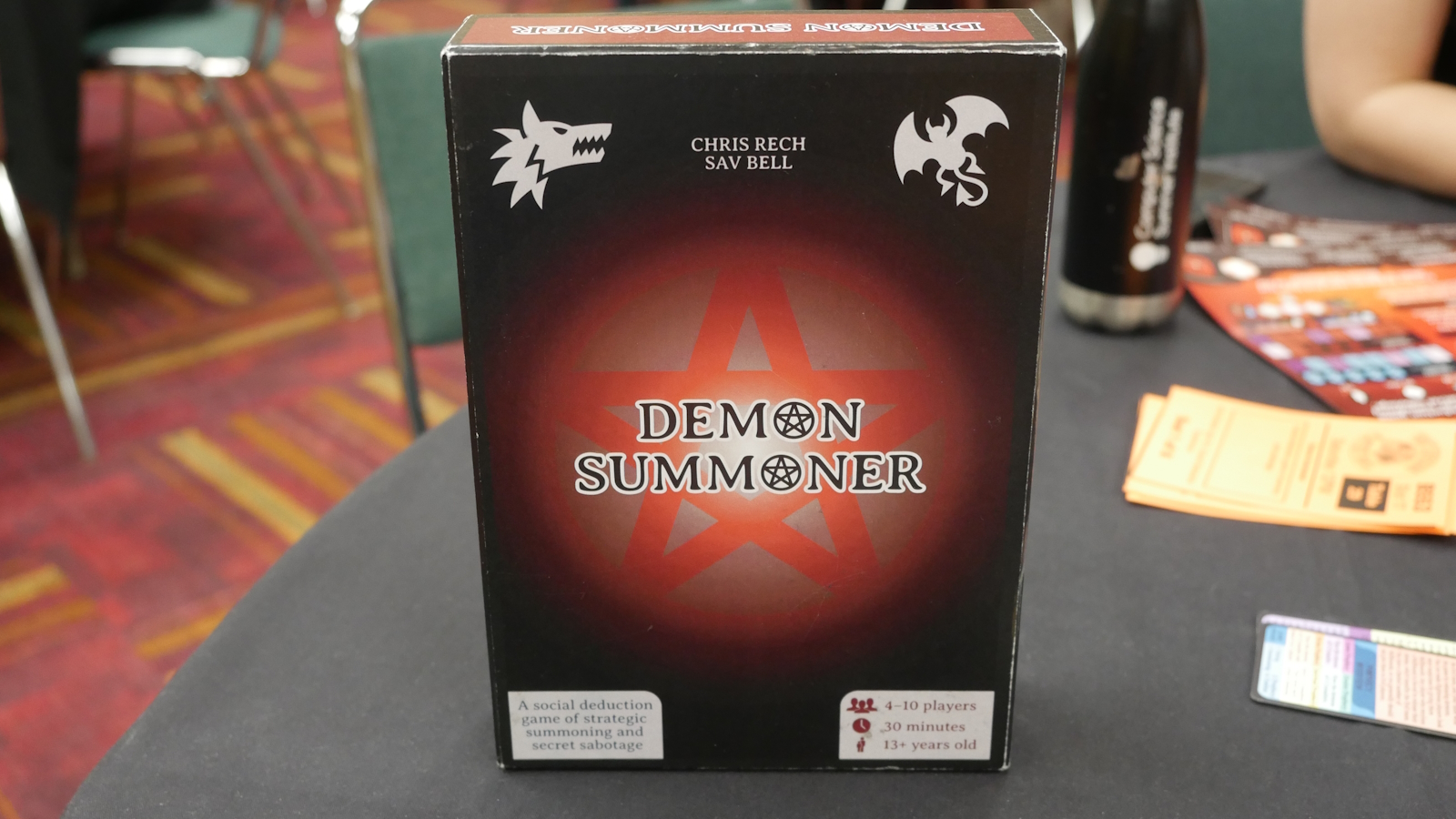
What makes all of this new and interesting is that one player has the special role of Demon Summoner. They reveal their role right at the start of the game and they are always on the evil team. When it is time for crusaders to receive their demons, it is the Demon Summoner that chooses which demon each player receives. The Demon Summoner knows who the evil players are so they can give Hellhounds to the righteous players, forcing them to release the demon and sowing distrust among the righteous team. Hellhounds are a limited resource however, so the Demon Summoner needs to use them sparingly. In our eight player game there were five Hellhounds and 15 Imps, all of which were used by the end of the game. All released demons are played face down so that nobody can really know if they were given a Hellhound or if they are actually evil. However, each round after demons are given, the leader is allowed to use a prophecy. There are a few different prophecies, but mostly they allow for the leader or someone else to view the demon of another player. This can potentially confirm that a player was given a Hellhound or cause more confusion when one player claims they saw an Imp and another claims that it was a Hellhound as they release it bringing the evil team one step closer to winning.
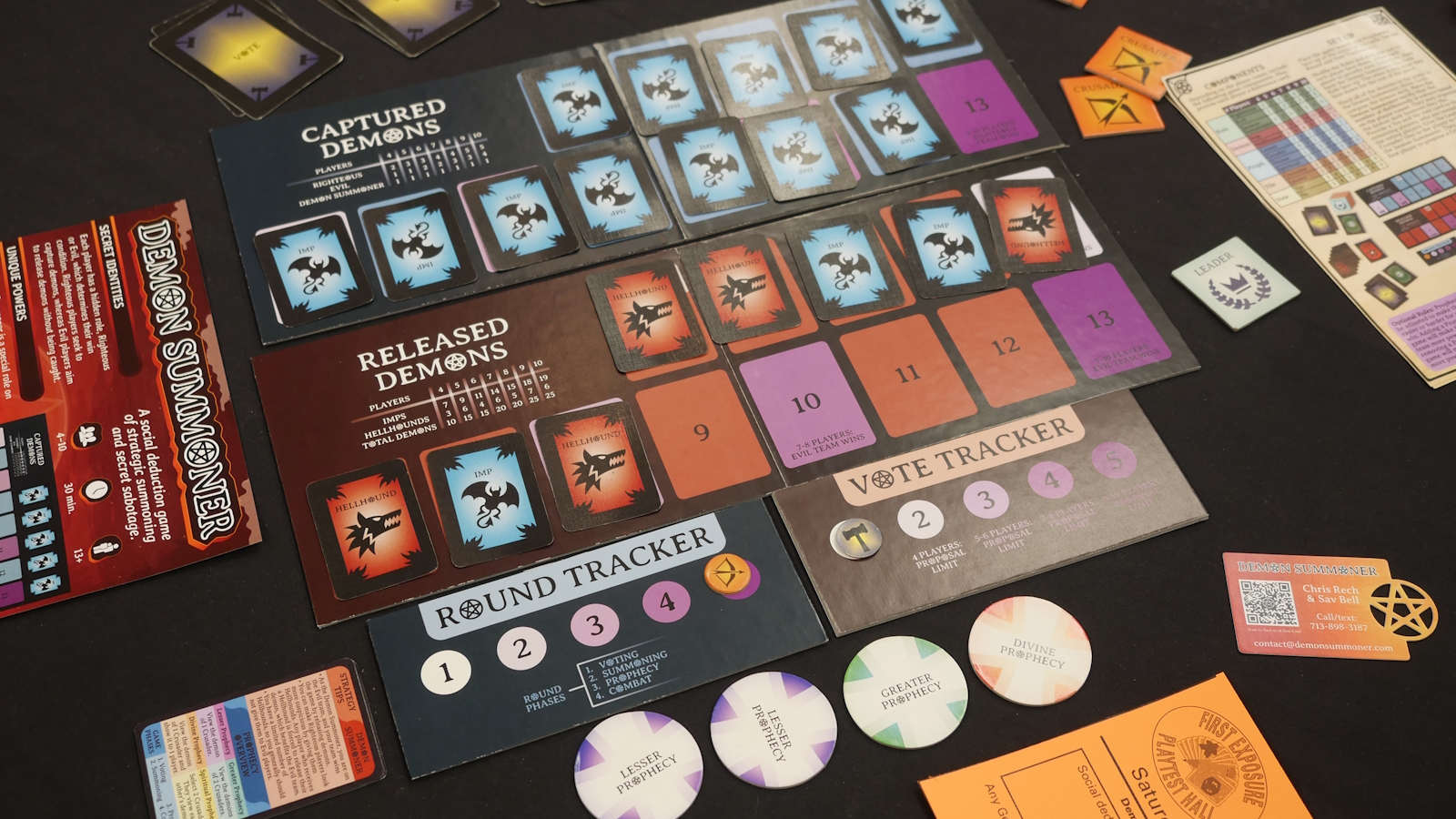
The addition of the Demon Summoner role really adds a lot of decision making and strategy to the game. Deciding when to try and discredit a righteous player or perhaps make an evil player seem good if you suspect a prophecy will be used against them. If one player is perhaps less confident in their deception abilities, they could simply be given the Demon Summoner role. The Demon Summoner can’t openly discuss with their fellow evil players, so they will often try to set up situations and hope that the other evil players will make the right decisions. If you have a regular social deduction group then I think this one is definitely going to be worth checking out once it is finally released. You can get more information at https://www.demonsummoner.com!
Angry Town: The Fighting Card Game
Angry Town: The Fighting Card Game by Ten Thousand Tales Games is designed by Vincent Burris with art by David Tarry. It is a two player head to head fighting game modeled after modern fighting video games. In Angry Town the elections for mayor are determined by the strongest (or dirtiest) fighter. There is a ton of crude humor in the game as characters such as Rabi McSlam and Flower Scout Tyrannia take to the streets.
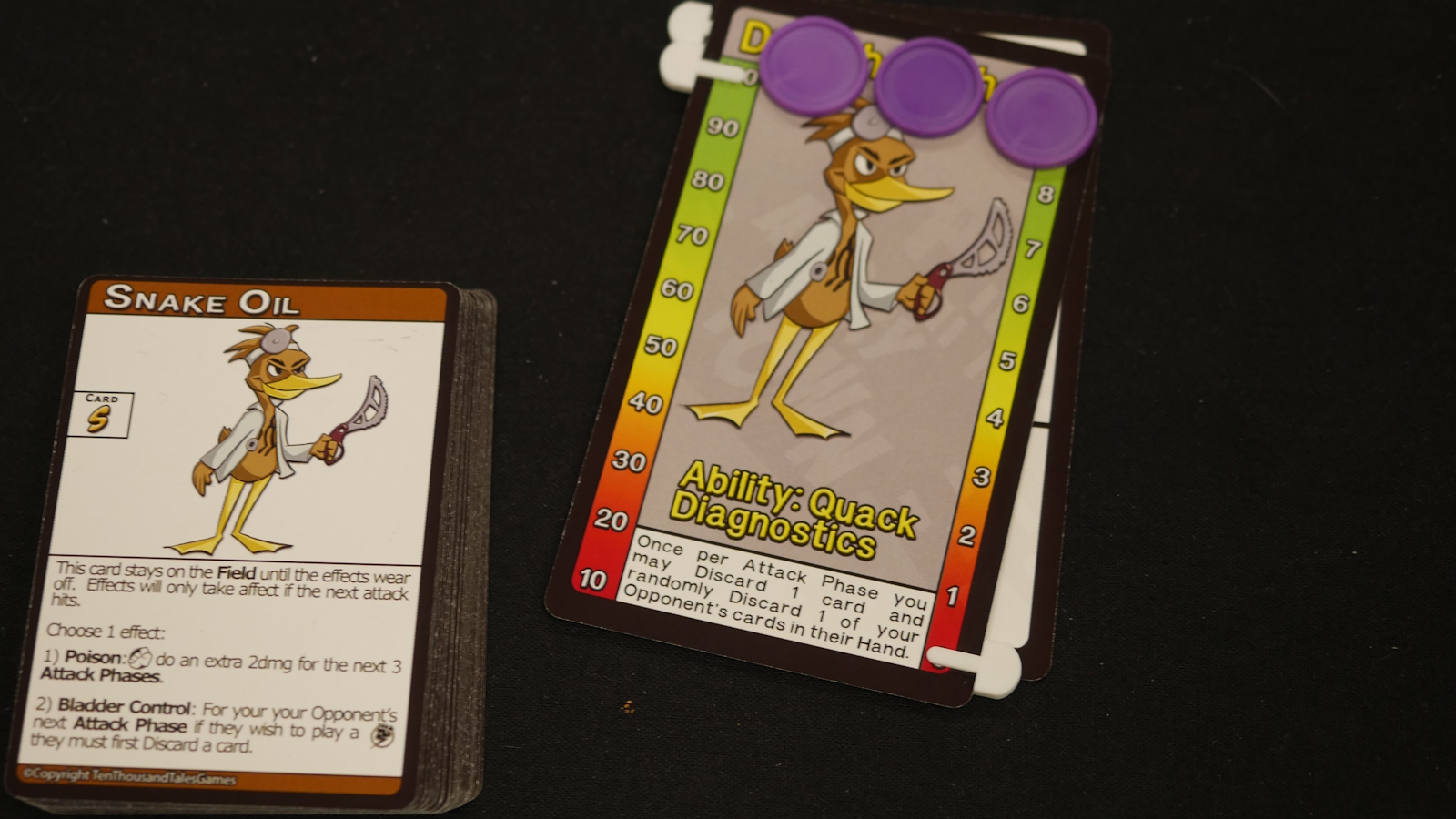
Each player starts with a unique character and deck of cards. Everyone has 100 health and a power meter that goes from one to ten. At the beginning of each round both players draw up to a hand of seven cards. The first player is chosen randomly at the start of the game and will alternate each round. On your turn you can play any number of cards, one at a time. Cards will have different attack types such as standing, low, jump, and throw and they will be normal or special attacks. Each card can also potentially block an attack of a specific type. After the active player plays a card their opponent decides if they want to play a card as defense. If they do not, the attack hits doing damage and potentially causes other effects as well.
Each attack may be classified as a starter, linker, or finisher. If a player hits with a starter they can then play any number of linker cards and end with a finisher, none of which can be blocked. The exception to this is that the defender can potentially play a counter card to break out of the combo. Landing combos is one of the primary ways of building up power which can be used to boost some cards or to use special abilities. There are also other rules involving throws and guard breaks, plus each character has their own special abilities.
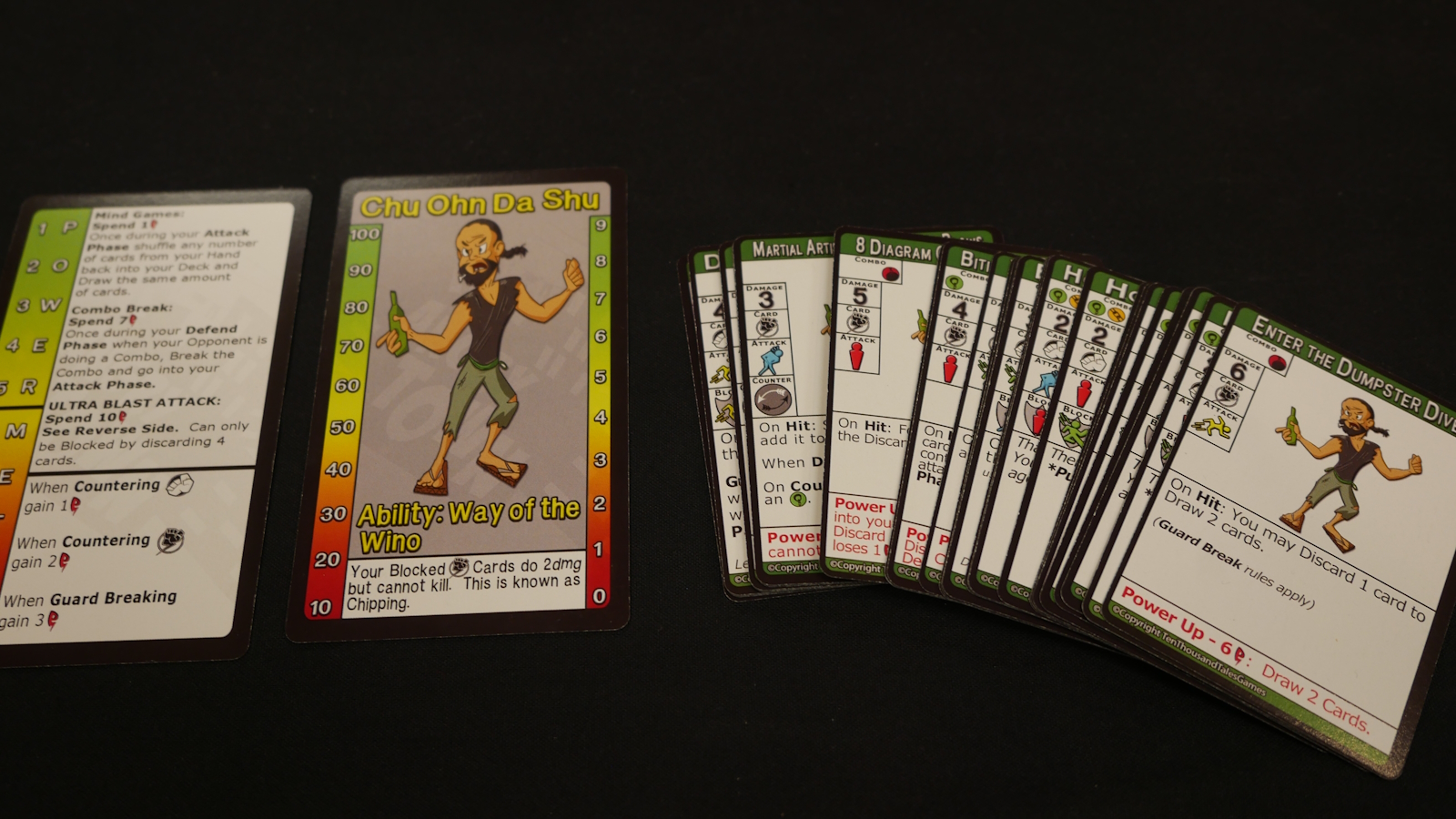
After the active player is finished playing all of the cards that they want they then pass and their opponent becomes the active player. Once both players have passed consecutively the round ends. Players continue to fight until one player has run out of health or cards in their deck. If a deck runs out the players play one more round and whoever has the most health left wins the match.
The fighting genre in video games is huge and I still think there is enough space in the board gaming realm to fit more games of this type. This one will particularly appeal to those that like this sort of crude humor. Ten Thousand Tales Games plans on bringing Angry Town to crowdfunding soon!
Path to Xibalba
The final game that I was able to playtest was completely unexpected. I met the folks from Jalapeño Games in the first exposure playtest hall where they heard that I was with GamingTrend and offered to show me their prototype of Path to Xibalba. It is a game they have been developing for six months and is a soccer-like sport in a fantasy Mayan setting.
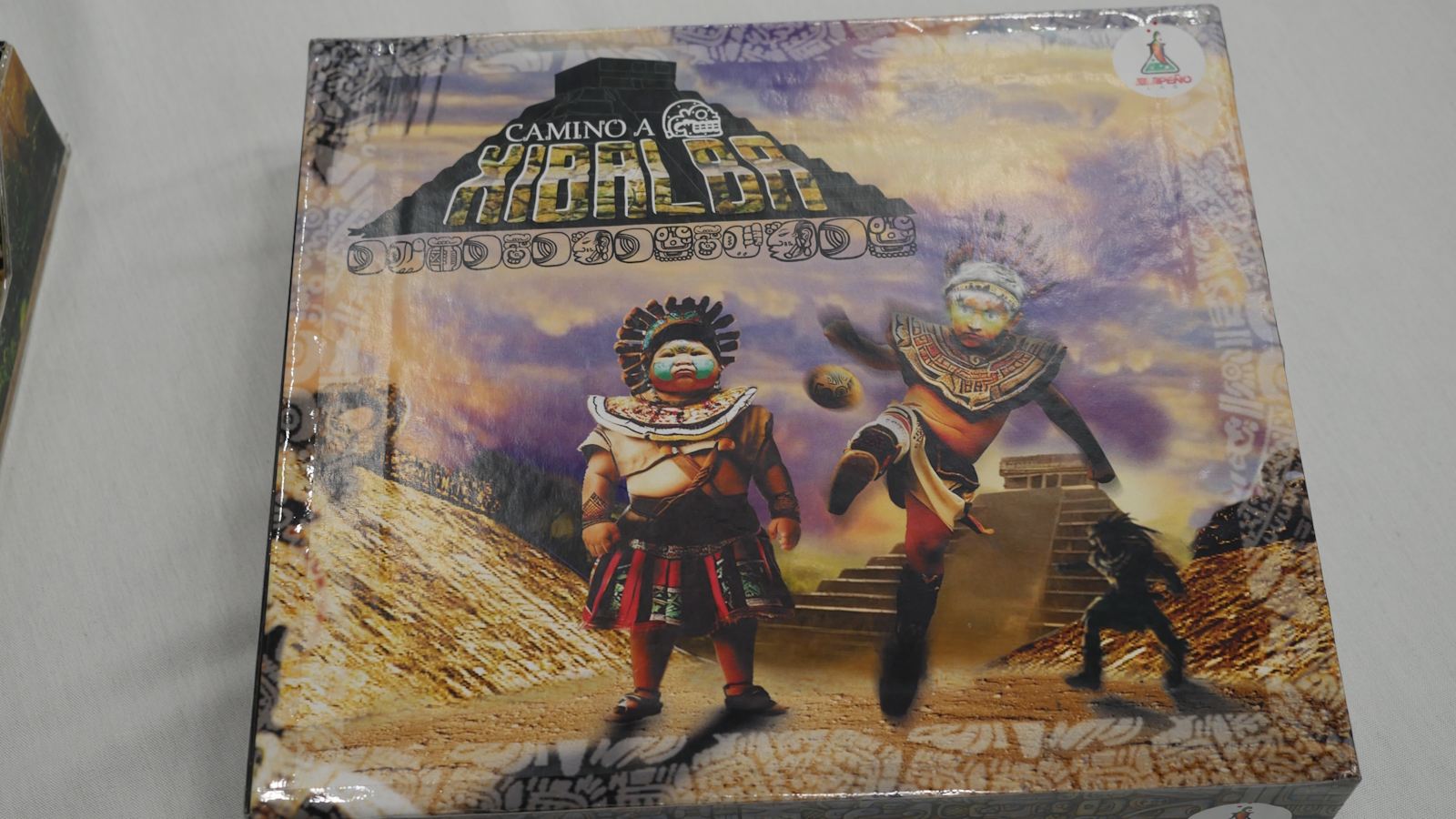
The game board is built into the bottom of the box. Players field three different types of generic units and one captain on a 5 x 11 grid. Each player puts up a little wall to hide their initial unit placement and chooses two of the three types of basic units to set up along with their unique captain. The players then alternate moving one unit at a time attempting to shoot the ball, which starts in the center of the field, into one of the two goals at the sides.

There are two main mechanics that I felt made this game stand out. The first is that there is a sloped column of spaces on each side of the board. You can’t move onto those spaces with your units, but you can shoot the ball towards them and it will roll up and down based on the angle of your shot. For the second feature it is important to know that players never hold the ball. When you move onto the ball you must shoot the ball. How far the ball moves is equal to how many spaces you moved in a straight line onto the ball. The basic units have movement very similar to chess. One type moves orthogonally like a rook and another type diagonally like a bishop. The third is sort of a hybrid that can also make knight style jumps, but remember you are only fielding two types at a time. So what is so interesting is that you always have to shoot the ball in a different direction than movement of the unit, orthogonally or diagonally. So if a unit moves orthogonally onto the ball then they can shoot it in any diagonal direction. If they pass the ball by shooting it towards another unit then that unit also gets to shoot the ball but now it must switch directions again. So alternating between orthogonal and diagonal until the ball lands in the open field or makes it to the goal.

On top of all of this you have the unique captains that have some really interesting abilities. One of them was a big unit that moved slowly but could throw other units around. Another was faster and could use telekinesis to curve the ball when shooting. They had a huge impact on how you played the game.
While playing Path to Xibalba I found that there were a ton of tactical and strategic decisions to make. For being a prototype the game felt very far along design wise. The built-in board made it very easy to set up and play with tons of variety and depth. This was a surprise preview of a game that I am now very much looking forward to seeing in the future!